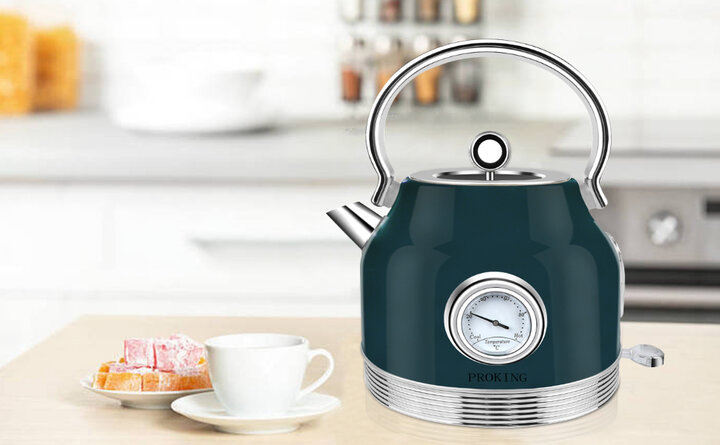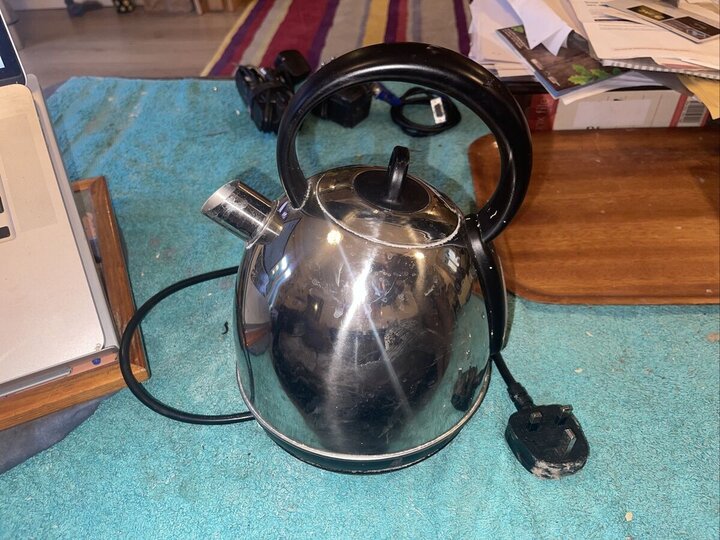Electric kettles are a household essential for many, providing hot water in just a few minutes. To use your electric kettle safely and efficiently, follow these guidelines.
Safe and Energy-Efficient Kettle Use
These tips will not only help protect your health and your family, but also significantly reduce your monthly electricity costs and prolong the life of your kettle.
 Do you know how to use your electric kettle safely and efficiently? (Photo: Amazon)
Do you know how to use your electric kettle safely and efficiently? (Photo: Amazon)
Choose the Right Kettle for Your Needs
Select a kettle with a capacity suitable for your household, avoiding oversized kettles that waste electricity. Look for high-quality materials such as stainless steel, heat-resistant glass, or premium plastic that’s safe for health.
When purchasing a kettle, consider safety features such as automatic shut-off when the water boils, boil-dry protection, and a convenient 360-degree swivel base. Reputable brands often offer quality products with essential safety features.
Keep Your Kettle in a Dry Place
Always keep your kettle in a dry, well-ventilated area, out of the reach of children and away from flammable objects. Do not place the kettle near water sources or in damp areas like bathrooms, as this can damage the electrical components and lead to electrical faults or even life-threatening situations.
Additionally, ensure the kettle is placed on a flat, stable surface to prevent accidental spills or tilting during boiling.
Proper Use and Regular Cleaning
Pay attention to the minimum and maximum water level indicators in your kettle and do not overfill or underfill it. If you notice any abnormalities, such as the kettle not turning off automatically, emitting strange sounds, or producing a burnt smell, stop using it immediately and have it checked or repaired.
To ensure efficient performance and energy savings, regularly clean your kettle to remove scale and mineral buildup. Use diluted white vinegar or lemon juice to clean the kettle, then boil and rinse thoroughly with water.
Boil Only the Amount of Water You Need
A simple way to save energy is to boil only the amount of water you require. Avoid the habit of filling the kettle to the brim when you only need a small amount, as this wastes electricity and prolongs boiling time, reducing the kettle’s lifespan.
Estimate the necessary amount of water for each boil. If you’re making a single cup of tea, fill the kettle accordingly. This saves energy and reduces waiting time.
Unplug the Kettle After Use
 Always unplug your kettle after use for safety and energy savings. (Photo: eBay)
Always unplug your kettle after use for safety and energy savings. (Photo: eBay)
After using your kettle, remember to unplug it from the power outlet. This simple step helps prevent accidents, saves energy, and reduces the risk of fire or overheating. It’s especially important if you have young children, as unplugging the kettle keeps them safe from accidentally turning it on.
Regularly Inspect the Power Cord and Plug
The power cord and plug of your kettle are crucial but vulnerable components. Regularly check for any signs of damage, looseness, or charring. If you notice any issues, replace or repair them immediately to ensure your safety.
Do Not Open the Lid While Boiling
Keep the lid closed during boiling to maintain safety and efficiency. Opening the lid while the water is boiling can reduce heat efficiency, causing the kettle to work longer and consume more energy. Additionally, sudden lid removal can result in hot steam escaping, posing a scalding risk.
Use Your Kettle During Off-Peak Hours
If possible, use your kettle during off-peak hours for electricity, typically early mornings or after 10 pm. During peak hours, electricity rates are higher, and voltage fluctuations can occur. Boiling water during off-peak hours will help you save on your electricity bills.
Only Boil Water in Your Kettle
Electric kettles are designed specifically for boiling water. Do not use them for other purposes, such as heating milk, cooking porridge, or boiling eggs. These activities can damage the kettle or lead to hazardous situations like boiling over or burning. Use appropriate cookware for heating other types of food.
Choose a Kettle with Suitable Wattage
Kettles come with varying wattages, typically ranging from 1,000W to 2,200W or higher. For boiling water for a few people, choose a moderate-wattage kettle to save energy. If you require faster or larger quantities of boiled water, opt for a higher-wattage kettle, considering the corresponding increase in electricity consumption.
Source: VTC

































